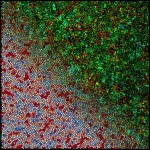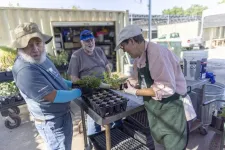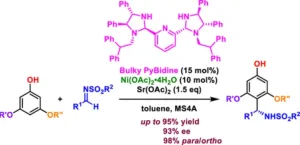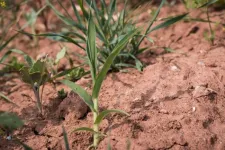How eelgrass spread around the world
An international research team led by GEOMAR reconstructs the worldwide colonisation history of the most widespread marine plant
2023-07-20
(Press-News.org)
Seagrasses evolved from freshwater plants and use sunlight and carbon dioxide (CO2) for photosynthesis and are able to thrive in depths down to 50 metres. In contrast to algae, they possess roots and rhizomes that grow in sandy to muddy sediments. The grass-like, leaf-shoots produce flowers and complete their life cycle entirely underwater. Seeds are negatively buoyant but seed-bearing shoots can raft, thus greatly enhancing dispersal distances at oceanic scale.
As a foundational species, eelgrass provides critical shallow-water habitats for diverse biotas and also provides numerous ecosystem services including carbon uptake. Seagrasses have recently been recognised as one of the important nature-based contributions to store carbon in the ocean. The sediment below seagrass meadows can sequester between 30 and 50 times more carbon annually that the roots of forests on land. Unfortunately, the continuing loss of seagrass beds worldwide – including eelgrass – is of acute concern.
An international group of researchers coordinated by Professor Thorsten Reusch, Head of the Research Division Marine Ecology at GEOMAR Helmholtz Centre for Ocean Research Kiel, used complete nuclear and chloroplast genomes from 200 individuals and 16 locations to reconstruct and date the colonisation history of the eelgrass Zostera marina from its origin in the Northwest Pacific Ocean to the Pacific, Atlantic and the Mediterranean. The findings described in a peer-reviewed publication and a Research Briefing published today in the scientific journal Nature Plants beg the question, “How well will eelgrass adapt to our new, rapidly changing climate?”
Using a phylogenomic approach the scientists were able to determine that eelgrass plants first crossed the Pacific from west to east in at least two colonization events, probably supported by the North Pacific Current. The scientists then applied two DNA “molecular clocks” – one based on the nuclear genome and one based on the chloroplast genome – to deduce the time when eelgrass populations diverged into new ones. The DNA mutation rate was calculated and calibrated against an ancient, whole genome duplication that occurred in eelgrass.
Both nuclear and chloroplast genomes revealed that eelgrass dispersed to the Atlantic through the Canadian Arctic about 243 thousand years ago. This arrival is far more recent than expected – thousands of years versus millions of years, as is the case with most Atlantic immigrant species during the Great Arctic Exchange some 3.5 million years ago. Reusch explains: “We thus have to assume that there were no eelgrass-based ecosystems – hotspots of biodiversity and carbon storage – in the Atlantic before that time. Recency was also mirrored in an analysis of the associated faunal community, which features many fewer specialised animals in the Atlantic as compared to the Pacific eelgrass meadows. This suggests that there was less time for animal-plant co-evolution to occur”, said Reusch. Mediterranean populations were founded from the Atlantic about 44 thousand years ago and survived the Last Glacial Maximum. By contrast, today’s populations found along the western and eastern Atlantic shores only (re)expanded from refugia after the Last Glacial Maximum, about 19 thousand years ago – and mainly from the American east coast with help from the Gulf Stream.
In addition, the researchers further confirmed the huge difference in genomic diversity between the Pacific and Atlantic, including latitudinal gradients of reduced genetic diversity in northern populations. “Both Atlantic compared to Pacific populations, and northern versus southern ones are less diverse on a genetic level than their ancestors by a factor of 35 among the most and least diverse one”, summarised postdoctoral scientist Dr. Lei Yu, first author of the publication which was a chapter in his doctoral thesis. “This is due to bottlenecks arising from past ice ages, which raises concerns as to how well Atlantic eelgrass, will be able to adapt to climate change and other environmental stressors based on its genetic capacity.”
“Warming oceans have already caused losses of seagrass meadows at the southern range limits, in particular North Carolina and southern Portugal. In addition, heat waves have also caused losses in shallow waters in some the northern parts of the distribution,” noted Reusch. “This is not good news because seagrass meadows form diverse and productive ecosystems, and no other species is able to take on the role of eelgrass if meadows cannot persist under future conditions.”
“One possibility for restoration might be to borrow some genetic diversity from Pacific eelgrass to fortify diversity in the Atlantic. Our next step is to interrogate the eelgrass pangenome. A new reference genome from Pacific eelgrass is currently under development and should tell us more about the adaptive ecotypic capacity across its global range of habitats,” said Prof. Jeanine Olsen, emeritus professor from the University of Groningen who initiated the study and coordinated the work between the Joint Genome Institute (JGI) and the research team. Thus, the verdict on rapid adaptation is out but there’s reason for optimism.
END
ELSE PRESS RELEASES FROM THIS DATE:
2023-07-20
WASHINGTON, DC – The Patient-Centered Outcomes Research Institute (PCORI) today announced the approval of $9 million for the first seven studies through its groundbreaking Science of Engagement initiative. An unprecedented research program dedicated to funding studies to demonstrate how best to engage patients, caregivers and other health care community members in comparative clinical effectiveness research (CER) and other health research, the initiative aims to grow a more robust evidence base to advance patient-centered, community-driven approaches to conducting research.
Since ...
2023-07-20
Individual palladium atoms attached to the surface of a catalyst can remove 90% of unburned methane from natural-gas engine exhaust at low temperatures, scientists reported today in the journal Nature Catalysis.
While more research needs to be done, they said, the advance in single atom catalysis has the potential to lower exhaust emissions of methane, one of the worst greenhouse gases, which traps heat at about 25 times the rate of carbon dioxide.
Researchers from the Department of Energy’s SLAC National Accelerator Laboratory and Washington State University ...
2023-07-20
Patients and members of the public will be able to more easily take part in impactful research thanks to a new tool developed by the University of Birmingham’s work on Long COVID.
These resources are detailed in a paper published today in Nature Medicine from researchers working within the University of Birmingham’s Institute of Applied Health Research, the NIHR Birmingham Biomedical Research Centre (BRC) and NIHR Applied Research Collaboration West Midlands, reporting the evaluation ...
2023-07-20
Like us, cells communicate. Well, in their own special way. Using waves as their common language, cells tell one another where and when to move. They talk, they share information, and they work together – much like the interdisciplinary team of researchers from the Institute of Science and Technology Austria (ISTA) and the National University of Singapore (NUS). They conducted research on how cells communicate – and how that matters to future projects, e.g. application to wound healing.
What comes to your mind when you think of biology? Animals, plants, theoretical computer models? The last one, you might not associate with it right away, although ...
2023-07-20
Key Takeaways:
Volunteering later in life may protect the brain against cognitive decline and dementia.
New study of older adults found better memory and executive function among those who volunteered.
Watch the video.
(Sacramento) Volunteering in late life is associated with better cognitive function — specifically, better executive function and episodic memory. Those are the findings of a new study from UC Davis Health presented today (July 20) at the Alzheimer’s Association International Conference 2023 in Amsterdam.
“We ...
2023-07-20
From life-saving drugs and synthetic polymers to diverse advanced materials, the products containing organic compounds seem endless, thanks in part to regioselectivity, a feature in chemical reactions where a substituent is selectively added to a specific position of an organic compound. This favors the formation of desired products with specific functionalities. One notable regioselective reaction used for the precise design of organic compounds is the Friedel−Crafts reaction, which enables the addition of substituents to specific positions on aromatic compounds ...
2023-07-20
Omega-3 fatty acids appear promising for maintaining lung health
NIH-funded study supports new role for nutrient found in fish, dietary supplements
Omega-3 fatty acids, which are abundant in fish and fish oil supplements, appear promising for maintaining lung health, according to new evidence from a large, multi-faceted study in healthy adults supported by the National Institutes of Health. The study provides the strongest evidence to date of this association and underscores the importance of including omega-3 fatty acids in the diet, especially given that many Americans do not meet current guidelines. Funded largely by the National Heart, ...
2023-07-20
Climate change is affecting the types of plant varieties we can cultivate, as well as how and where we can do so. A new collection of articles in the open access journal PLOS Biology explores the twin challenges of engineering plants for resilience to climate change and enhancing their carbon-capture potential. PLOS Biology Editors Pamela Ronald & Joanna Clarke provide a summary editorial, and details regarding the other papers may be found below.
To meet the agricultural challenges caused by climate change and a growing population, we need to improve crop production. This Perspective from industry leaders including Catherine Feuillet calls for more and better ...
2023-07-20
NEWPORT NEWS, VA – A doctoral dissertation examining the most precise measurement of electron beam polarization ever made was just awarded the prestigious 2022 Jefferson Science Associates (JSA) Thesis Prize. Since 2017, award-winner Allison Zec has been part of a collaboration that ran experiments at the U.S. Department of Energy's Thomas Jefferson National Accelerator Facility.
The goal of both the CREX and PREX-II experiments was to run an experiment and its mirror opposite simultaneously to determine ...
2023-07-20
ATLANTA, July 20, 2023 – A new study from researchers at the American Cancer Society (ACS) found that Black cancer survivors in the United States experience a higher risk of dying from cardiovascular disease (CVD) compared with White cancer survivors. The research showed Black cancer survivors carry from 30% up to a three-fold higher mortality risk from CVD, depending on the type of cancer that was diagnosed. Differences in neighborhood socioeconomic status and health insurance between Black and White cancer survivors explained the disparities in cardiovascular death rates between populations, according to the study authors. ...
LAST 30 PRESS RELEASES:
[Press-News.org] How eelgrass spread around the world
An international research team led by GEOMAR reconstructs the worldwide colonisation history of the most widespread marine plant







